The photos below are snapshots from the 3D program used to create the master figure
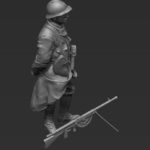
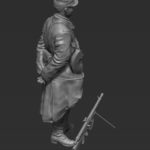
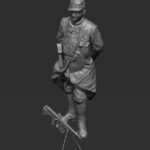
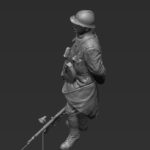
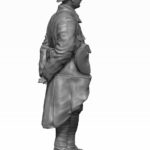
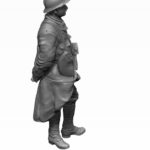
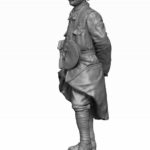
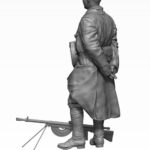
See the 1:16 painted version (with base).
French Infantryman Chauchat MG Gunner, 62nd Regiment
- Scale / Maßstab: 1:35 / 50mm
- Approx. height of figure / ca. Höhe der Figur: 50mm
- Material: Resin
- Parts / Teile: 15
- Infosheet / Infoblatt: English
- Code: 35SCG
Contents / Inhalt:
- Figure (3 parts) / Figur (3 Teile)
- Head with Kepi / Kopf mit Käppi
- Alternative Head (Adrian Helmet) / 2. Kopf (mit Adrianhelm)
- 2 CSRG Frontal Magazine Pouches (1st type) / 2 Stck. CSRG Magazintaschen (Typ 1)
- Ruby Pistol Pouch M1916 / Ruby Pistolentasche M1916
- Chauchat Mle. 1915 MG / Chauchat Mle. 1915 MG
- Bipod Legs / Zweibein
- Spare Bipod Legs / Ersatzteile – Zweibein
- Common European Frog (Rana temporaria) on Stone / Grasfrosch auf Stein
Extracts from the Infosheet with this figure:
The figure is based on a French Chauchat MG Gunner of the 62nd Infantry Regiment photographed at Mericourt sur Somme, 12th November 1916. Here he has been awarded with the British Military Medal (probably presented by the Duke of Connaught). For what reason he received this medal and in which area of combat is unknown. The official movements of this regiment from March 1916 to January 1917 gives Verdun, but a battalion, or smaller unit may well have been attached to another Army Group, possibly during the Somme battle. Their battle history is: Marne, 1st Aisne, Champagne, Verdun, 2nd & 3rd Aisne and Meuse-Argonne. The home base for the 62nd was Lorient, Brittany.
He carries a reduced amount of equipment, which would normally not be sufficient for combat.
To date I have only come across the 2 original photographs of this soldier. The original head wearing the Adrian helmet shows a slightly bent nose, which is more evident in the 2nd, less known photograph.
Uniform
Other Ranks Infantry Kepi Model 1884/1914 / Képi d’Infanterie, modèle 1884/1914: The 2nd, alternative head wears the earlier type M1884 /1914 Kepi in gris bleuté. From the end of 1914, beginning of 1915, one saw more and more French troops wearing the new simplified kepi M1914 version (without piping), but there were still many of the old caps around, especially with reserve and territorial units. The chin-strap and visor were still made out of blackened leather, with Tombac (or sometimes zinc) buttons and black painted vents at each side.
One can display this kepi in at least 2 different coloured versions. Both original items were used as references during the making of this figure. The old-type red regimental numbers on dark-blue backing were often removed from the older, pre-war red kepis and remounted to the new types, giving quite a mixture of headdress colours.
Possible Kepi Colours:
Version 1: Blue kepi with yellow piping. Red sewn-on regimental cloth patch on dark-blue backing.
Version 2: Blue-grey (gris bleuté) kepi with dark-blue piping. Regimental number as in version 1.
There are also versions of this kepi with the regimental numbers showing a dark-blue on light-blue backing cloth. The unit numbers on figure have been modelled slightly more raised than would normally be the case for cloth patches – this is to enable an easier paint finish.
Neck Cloth / Cravate: Seems to be a private item and in a somewhat lighter colour than the Service Tunic collar.
Service Tunic M1914/15: On the original photograph, under the greatcoat collar one can see parts of the service tunic M1914/15. Normally, the greatcoat was the regular combat uniform of the French Army and the tunic would only be worn in the warm months of summer. However, in colder conditions, a combination of both greatcoat and tunic were worn together giving sometimes a bulky appearance to the soldier. The collar patches for infantry regiments were normally mounted on a horizon blue backing cloth, with darker blue regimental numbers and vertical stripes (white No. and stripes were used for reserve / territorial units).
Greatcoat Model 1914/1915 – 3rd Type / Mle.1914/15 Capote: This was a simplified version of the original M1877 dark blue greatcoat. The two large pockets (partly hidden behind the turned up flaps) were added towards the end of 1915 and often one sees theses made out of a different coloured material. The pockets were reinforced from within and intended for the carrying of extra ammunition. It had a large turned down collar with grey-blue metal buttons (although these tend to reflect the light somewhat, giving a shiny appearance sometimes) at the front and smaller ones on the pockets and at rear waste belt.
The distinctive turned up coat flaps were buttoned back at each sides – here the material was reinforced at the corners. On his upper left arm are the 3 dark-blue chevron stripes, mounted on a light blue backing cloth, indicating the time served at the front. The first stripe for 1 year, with every successive stripe for ½ year service. The colour of these greatcoats varied considerably and depended on the dye used, origin, wear and tear and age of the garment.
On the original photograph the service stripes appear much lighter than they should be. This could well be due to fading, or are of a different coloured cloth altogether.
The dark-blue 62 sewn-on regimental collar patches have been modelled slightly more raised than would normally be the case in this scale – this is to enable an easier paint finish. Casting webs have been placed under the coat collar, top pocket flaps, behind / within magazine pouch attachments and belt end (bottom part, protruding out). These can be removed before painting.
Also, the original photograph shows what looks like a fastening strip between the coat collar ends. This is normally not a feature of these coats and I have only seen this on versions for cavalry and train (transport). This may well be a variant from a particular manufacture or an add-on feature carried out locally or by soldier. Also, one cannot see the bottom pocket flaps. Here they have either been pushed into the pocket openings, or are missing altogether. The top pockets seem to be quite full, with corners of contents showing up on the outer cloth (more evident on right hand pocket). Also evident is the fact that there are 2 greatcoat buttons missing from a total of 6 at the front (1 is behind belt).
On the greatcoat itself, the structure and fold of the creases follows the standard form copied from various photos of French troops in the field. It is always better when gathering reference material to use original photos of troops who have been actually wearing their uniforms over long periods of time, as most garments (as indeed all types of clothing, depending on the material used) will crease and fold in roughly the same way. Some reference books, especially for collectors of uniforms are helpful for colour-reference and information etc., but will not always portray an accurate picture of how the uniforms appeared after many days of being worn.
British Military Medal (MM): This French soldier has been awarded the Military Medal, which although generally intended for British personnel, was known to have Commonwealth and other Allied troops as recipients. The MM was the other ranks equivalent of the Military Cross (MC), which was awarded to Commissioned Officers and on the odd occasion to Warrant Officers, for bravery in battle on land. Established in March 1916, the MM was never as popular as the higher ranked Distinguished Conduct Medal (DCM), which had a money grant of twenty pounds and a sixpence a day bonus added to the soldier’s pension.
The medal ribbon is flanked by 2 dark blue thicker stripes, centred by 5 equal stripes, 3 white and 2 red. The obverse (the side of a coin or medal bearing the head or principal design) shows an image of the reigning monarch – in this case, King George V. The suspender (attachment between medal and ribbon) is decorated with scrolls. As this medal has been newly presented, it will not have signs of the normal patina seen often on these items.
Other Ranks Knee Trousers for Infantry M1914 / Pantalon-Culotte Modèle 1914: These were a new type of wider Pantalons, designed to replace the earlier straight types. The trouser narrowed towards the knee, which was a necessity after the introduction of the puttee in October 1914. The front knee areas were reinforced with an extra square patch of material and a thin yellow stripe running down each outer leg indicated normally the infantry. Here again different trouser material used by the manufactures varied considerably in colour, but on many original photographs appear to be of a lighter shade than the greatcoats.
Leg Raps (Puttees) M1902 / Bandes Molletières M1902: In the French Army the puttee (an Indian word meaning bandages) was originally the sign of the Chasseurs Alpins, who had worn them since 1889. Designed to cover the gap between boot and trousers, keeping the lower leg warm and dry. The French puttee was approx. 2.60m long, 12cm wide and was sometimes worn in a criss-cross pattern in order to avoid gaps appearing, which invariably happened after constant use. Colour: grey-blue (darker than the trousers and greatcoat). Later during the war, these puttees appeared in different shades, ranging from dark brown to light horizon blue.
The original photographs show this soldier with untidy and uneven puttees, presenting the lower legs somewhat larger than would normally be the case. Maybe he is wearing extra thick socks underneath?
Other Ranks Boots M1912 / 1916 / Brodequins modèles 1912 / 16: The M12/16 boot, was a modified version of the erlier pre-war M1912 type. It had a higher shaft, with additional brass rivets at each side, below the eyelet tab, to prolong the life span (earlier models of he M12 boot would come apart along the side seams). Made out of brown leather, with the rough side outwards and featureing nails in the heel and studs under the sole (outer sole). Earlier boots had copper eyelets, which were replaced later in the war with aluminium.
The pattern and amount of nails / studs under the French Army M1912/16 boot varied. I have copied the most widespread type, with the typical blank area at forward outer edge of sole.
Between the figure mounting blocks and underside of boots there is a gap, which has been filled by a casting web. This can be removed before fixing figure to base if required. This will allow one to look under and through the gaps.
Equipment
Adrian Infantry Helmet M1915 / Casque Adrian de l’infanterie française modèle 1915: The Adrian helmet, similar to the fireman, or dragoon helmets of the period and first appeared in sufficient numbers for the Champagne offensive in September 1915. By December 1915 a total of 3 million had been produced. Weighing only 765 grams and formed from relatively mild steel, it did not give as much protection as the German and British counterparts. On the front is the grenade of the infantry (this would differ according to the arm of the service). Colour: the first helmets to be introduced had a shiny blue-grey finish, which by December 1915 were being covered with a khaki cloth cover. From the summer 1916 the helmets were issued in a blue-grey matt colour and were now worn without the cloth covers again (this was an official directive to avoid the cloth, which was never clean being dragged into head wounds, causing further complications).
Leather Belt and Brace Equipment M1892/1914 / Bretelle de suspension Mle 1892/14: The main difference from the early pre-war equipment was that since December 1914 all belts, braces and straps etc. were issued now in brown, instead of black. Also, the shoulder and rear straps are now fixed to the metal ring by means of brass rivets, rather than stitched on. The belt now has a steel two pronged buckle.
Ruby Pistol Pouch M1916 / Cartouchiere Francaise Pour Pistolet Ruby: The special brown leather holster for the Ruby pistol was similar to the standard infantry cartridge pouch, but slightly larger. It was attached with the aid of a tin-plated iron suspension ring and hook to the brace (yoke) equipment and 2 loops to the belt. A brass stud at the front held the pouch flap down. The pouch held the simple, compact, but robust Spanish made Ruby pistol, with 2 additional magazines and was the standard secondary weapon of all French GCRG gunners.
CSRG Frontal Magazine Pouches (1st type): Issued in the spring of 1916 to all CSRG gunners. These distinctive, half-moon shaped Chauchat magazine pouches were made from a thick brown leather and were at first worn with the convex sides facing inwards. Later, these pouches were swapped over on the webbing to enable a better access of the magazines by the gunner. The 2nd type version, which appeared in the summer 1917 had an additional strap fixed to the convex parts and around the gunner’s back, joining both and so keeping the pouches closer to the body during combat.
These pouches were not popular with the troops. They proved uncomfortable when firing the gun in the prone position (laying down) and the magazines were easily damaged within. Additionally, their characteristic shape, outlined against the lighter colour of French uniforms, became recognizable and an obvious target for German infantry. Two magazines would fit into each pouch, the feed-lips facing downwards and held in place with an outer flap / strap, fixed with brass stud fasteners.
Quite often the shape of the magazines would show up on the outside of pouch, reflecting the light from the slightly raised parts. This is the case on the original photograph. It also appears that the pouches are both empty, with the right hand one left open. Casting webs have been placed at one of the pouch flap fastening studs and within the hanging down straps. These are to be removed before assembling / painting.
Weapon
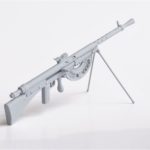
Chauchat Mle. 1915 MG / Le fusil-mitrailleur de 8 mm CSRG modèle 1915: (above image of 1:16th version) Usually referred to as the Chauchat MG and no doubt one of the most controversial weapons of the WW1. Within months of the outbreak of the war, both the German and Allied armies were developing a lighter machine gun to improve the infantry section’s fire power. The established Maxim, Vickers and Hotchkiss machine guns were all too heavy and mostly employed in the static role of trench warfare. The requirement was for a lighter, portable automatic rifle or light machine gun, to be carried into battle by a gunner and loader / carrier and protected by the section riflemen. The British introduced the Lewis MG, with the distinctive round magazine (also used by the Germans) and the Germans developed their Maxim MG08 into the lighter 08/15 MG.
French Army Capt. Louis Chauchat, together with the Charles Sutter had started developing automatic rifles before the war, with generally good results. They were also looking into the new industrial manufacturing techniques of hydraulic stamping to form parts from sheet metal, rather than milling solid blocks of steel. In 1913, a simple Chauchat-Sutter machine rifle had been developed using tubing and stamped, riveted sheet metal. After initial trials and the outbreak of hostilities, the first 100 production guns were allocated to the new French Air Service.
In 1915 an emergency order was placed for 50.000 machine guns of the Chauchat-Sutter type. The contract was awarded to the Paris Bicycle & Motorcar Company Gladiator for a ground version of the initial design, incorporating a bipod, wooden stock and the infamous crescent-shaped magazine, now relocated to underneath the gun. The official name CSRG derived from the surnames of both designers Chauchat and Sutter, the production manager Paul Ribeyrolles and the company Gladiator.
I have included both barrel types, giving a choice of year to present the figure. The cone-shaped flash hider appeared first in January 1917 and is generally the most common MG type ones sees on photographs. As the original photographs were from November 1916, then he would most certainly have been issued with an early version MG type, without flash hider. The posing of figure, standing on the cobbled road, with the MG at his feet is purely my own interpretation.
Bipod Legs: At the forward bipod fixing attachment, there are small casting webs within the gaps – these are to be removed before fixing the legs. The thin bipod legs had no rear-fixing attachment when folded upwards. Here I have quite often seen them held in place on top of the magazine release handle. The bipod legs can be place either in the down (firing position), or up carrying position.
These long and thin legs are delicate items and may break easily. One could replace the resin cast legs with simple wire ones, giving added strength to this MG.
To date I have only come across one WW1 photograph of German troops with the Chauchat MG, although there are quite a few from WW2. The Germans called the Chauchat MG französche Muskete.
Magazines (2nd type): One of the most serious problems associated with the CSRG are the flimsy, open magazines. The reason for the opening was to allow the carrier / loader to keep sight of rounds still left within magazine, enabling a quick change around. Additionally, the magazines would be damaged whilst carried in the gunner’s front pouches, causing stoppages. The standard French Army 8mm tapered round determined the shape of these magazines (unlike the US version CSRG, which used the .30-`06, therefore enabling a straighter magazine).
It was a common practice by combat veterans experienced with this MG to load the magazines with just 18 rounds, as opposed to 20 and was to restrict too much tension on the magazine spring, avoiding the danger of a weak feed.
The small hole on each side of magazine was a feature on the later, 2nd type versions. This was to enable the pusher (in front of magazine spring) to be held in place by inserting a round when loading the individual rounds. Depending on where the pusher is situated, one could look through this hole.
 An deutschsprachige Interessenten:
Sie können mich per eMail oder Telefon auch gerne auf deutsch kontaktieren. Ortsbesuch ist nach Absprache möglich.
An deutschsprachige Interessenten:
Sie können mich per eMail oder Telefon auch gerne auf deutsch kontaktieren. Ortsbesuch ist nach Absprache möglich.
